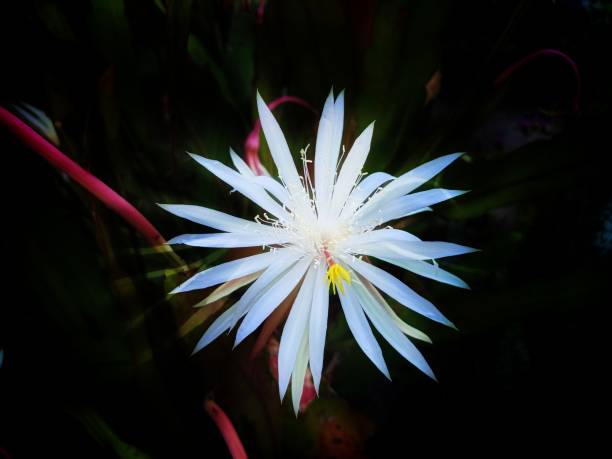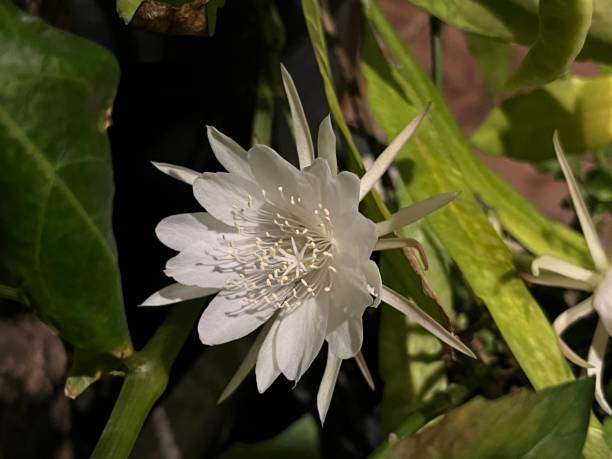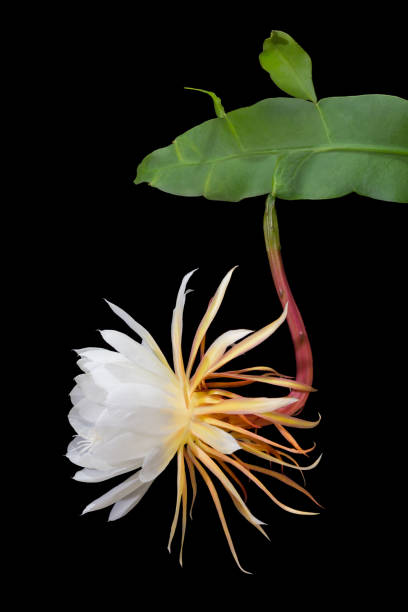
Welcome to our comprehensive guide on growing and caring for Epiphyllum, also known as Orchid Cacti. In this article, we will delve into the fascinating world of Epiphyllum, a genus of tropical succulents with over a dozen species and numerous hybrids. Our aim is to provide you with all the information you need to successfully grow and care for these beautiful plants, allowing you to create a tropical oasis in your own home or garden.
Understanding Epiphyllum
Epiphyllum, commonly referred to as Orchid Cacti or climbing cacti, is characterized by its long, flat, non-spiny, and trailing stems. These succulents are native to Central and South America and typically grow on branches or trunks of trees in their natural habitat, absorbing moisture and nutrients from the humid environment around them. In cultivation, Epiphyllums thrive in warm, humid, and shady spots, making them an excellent choice for indoor or sheltered outdoor environments.
Orchid Cacti Care

Light Requirements
Proper light conditions are crucial for the healthy growth of Epiphyllum. These plants thrive in filtered sunlight that mimics their natural habitat. While a few hours of full morning sun are beneficial, it’s important to protect them from intense midday sun to avoid scorching or white scabbing. If you’re growing Epiphyllum outdoors, hanging baskets in the shade of a tree provide an ideal environment.
Indoors, ensure that your Epiphyllum is not exposed to long periods of artificial light after sundown, as this can negatively impact flowering the following year. Insufficient light can result in wilted growth and yellowing, while too much shade may lead to leggy and delicate growth.
Soil and Potting Mix
Epiphyllums should not be grown directly in the ground as normal soil is overly compact for their roots. Opt for a loose and fast-draining potting mix that promotes proper drainage. An ideal mix includes azalea mix combined with additional perlite, bark, cocoa chips, or pumice. This ensures that the roots have access to the necessary nutrients while preventing waterlogging.
Watering Techniques
Maintaining a proper watering routine is crucial for the health of your Epiphyllum. Unlike traditional cacti, Orchid Cacti require regular watering during the growing season. Keep the potting mix moist but not soggy, allowing the top 1/3 of the mix to dry out before rewatering. In winter, reduce watering and relocate the plant to a cooler location. This period of reduced watering helps stimulate healthy and robust flowering in the next season.
Using distilled or filtered water is beneficial for these sensitive plants, as tap water may contain minerals that could harm them. Overly wet soil can lead to branch dieback or rust spotting, especially in low temperatures. If you encounter these issues, remove the affected branches, repot the plant in a dry and fast-draining mix, and adjust your watering practices accordingly.
Temperature and Humidity
Epiphyllums are sensitive to temperature fluctuations and thrive in specific ranges. If you’re growing them outdoors, it’s advisable to use pots or hanging baskets that can be moved indoors when temperatures drop. These plants cannot withstand frost or temperatures below 32 degrees Fahrenheit.
For indoor cultivation, adjust the location of your Epiphyllum during the winter and growing seasons. Spring to autumn temperatures up to 90 degrees Fahrenheit are optimal, while a cooler spot with filtered light is ideal during the winter, ranging from 50 to 58 degrees Fahrenheit. Higher humidity levels are also essential for their well-being. You can enhance humidity by placing the plant on a tray of wet gravel (ensuring the roots are not in direct contact with water), misting the stems, or using a humidifier.
Fertilization
Proper fertilization is essential for encouraging strong growth and stimulating bud development in Epiphyllums. However, it’s important not to overfeed these plants, as they naturally grow in low-nutrient environments. Opt for a balanced, slow-release fertilizer with a nitrogen content not exceeding 10%. Applying a 2-10-10 fertilizer in early spring can contribute to healthy blooms. Be sure to follow the manufacturer’s instructions and avoid excessive fertilization, as it may lead to nutrient imbalances or burn the roots.
Types of Orchid Cacti
Epiphyllum encompasses a wide range of species and hybrid varieties, each with unique characteristics. Here are some notable ones you might consider adding to your collection:
- Queen of the Night (Epiphyllum oxypetalum): This popular species is known for its rare, large, and fragrant flowers that bloom at night. The funnel-shaped flowers give the plant its other common name—the Dutchman’s pipe cactus.
- Climbing Cactus (Epiphyllum phyllanthus): If you prefer a smaller Epiphyllum, this stout species might be a perfect choice. While the flowers are smaller compared to other varieties, the beautiful pink tinge in the center adds an eye-catching touch.
- Epiphyllum ‘Wendy’: This hybrid variety features large pink flowers that bloom during the day, distinguishing it from true Epiphyllum species. However, it lacks the fragrance typically associated with Epiphyllums.
Pruning and Maintenance
Epiphyllums are slow-growing plants that can develop large and heavy trailing stems. To maintain an aesthetically pleasing appearance without unsightly supports, consider pruning the stems to a shorter length. The cuttings you remove can be used to propagate new plants, as new shoots typically grow behind the cut.
Propagating Epiphyllum

Stem cuttings offer the quickest and easiest method for propagating Epiphyllum, ensuring the new plants remain true to the parent plant. Follow these steps for successful propagation:
- Select healthy stem sections that are approximately 9 inches in length. Longer cuttings tend to result in faster flowering.
- Allow the wound to dry and fully callus (harden) for at least a week to prevent rot.
- Insert the cutting vertically into a fast-draining cactus potting mix, ensuring at least the bottom 1.5 to 2 inches of the stem is submerged.
- Place the cutting in a warm location with dappled light, making sure not to choose a pot that is too large. Epiphyllums prefer slightly root-bound conditions.
- Initially, mist the cutting and gradually increase watering once roots start to form. Ensure the potting mix remains damp but not soggy. Aim for a temperature of around 70 degrees Fahrenheit.
- It usually takes approximately one to six weeks for the cutting to develop roots and establish itself.
Growing Orchid Cacti From Seed
While Epiphyllum seeds are not readily available commercially, you can produce your own seeds through hand pollination. However, this method is more time-consuming and requires simultaneous flowering of male and female plants. Moreover, it can take up to four years for the plants to bloom. As a result, propagating from stem cuttings remains the most popular and practical method.
Potting and Repotting Epiphyllum
To ensure successful blooming, avoid using excessively large containers or hanging baskets for your Epiphyllum. These plants prefer a slightly root-bound environment and do not require frequent repotting. Repot them once every six to seven years, ideally after they have flowered to minimize root disturbance. Choosing a heavy container will provide stability as the trailing stems grow.
Common Pests and Diseases

Epiphyllums are generally resilient to serious pests and diseases. However, it’s important to keep an eye out for common issues such as mealybugs, aphids, fungus gnats, and red spider mites. Slugs and snails may also be attracted to the thick stems of these plants, but hanging them in elevated baskets can help minimize this problem. Regularly inspect your Epiphyllum for any signs of infestation or disease and take appropriate measures to address them.
Promoting Blooming in Orchid Cacti
Epiphyllums are renowned for their large and fragrant flowers. With the wide variety of cultivars and hybrids available, you can enjoy an array of colors, shapes, and sizes. However, it’s important to note that most main species produce short-lived white flowers that bloom at night. Flower sizes range from 1 to 12 inches, and their duration can vary from a single night to a week, with smaller flowers typically lasting longer. Flowering times can vary from April to July, although occasional off-season blooming may occur in early spring or fall.
To increase the likelihood of successful blooming, consider the following tips:
- Move your indoor Epiphyllum to a cooler location during the winter, reducing water intake while ensuring the plant never completely dries out. This seasonal change helps stimulate flower bud formation.
- Once the flower buds appear, return the plant to its normal, warmer location to facilitate proper blooming.
Frequently Asked Questions (FAQs)
How long can orchid cacti live?
Epiphyllums have a long lifespan and can provide interest and beauty for many years when provided with the right growing conditions. Consistent care in terms of watering, sunlight, and temperature is crucial for their longevity.
What other plants are similar to Epiphyllum?
If you’re looking for plants with similar growth requirements to Epiphyllum, consider holiday cacti (Schlumbergera). These succulents thrive in warm, humid, and moist conditions, with filtered sunlight. While Schlumbergera resembles Epiphyllum in terms of environmental needs, it grows at a faster rate and is generally smaller in size. Additionally, holiday cacti bloom in the fall and winter, providing a delightful contrast to the flowering seasons of Epiphyllum.
Is the fruit of Epiphyllum edible?
The small fruit produced by many Epiphyllum species is indeed edible. It is said to have a flavor similar to that of pitahaya (dragon fruit), which is a closely related plant. However, exercise caution when consuming the fruit, as individual sensitivities and reactions may vary.
Conclusion
We hope this comprehensive guide has provided you with valuable insights and knowledge on how to successfully grow and care for Epiphyllum, the Orchid Cacti. By following the guidelines outlined in this article, you can create an enchanting tropical oasis in your home or garden. Remember to provide your Epiphyllum with filtered sunlight, well-draining soil, proper watering techniques, and adequate humidity. With your dedicated care, you can enjoy the vibrant and fragrant blooms of these remarkable plants for years to come.





